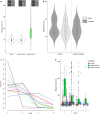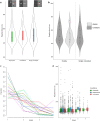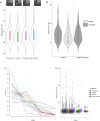Conscious awareness modulates processing speed in the redundant signal effect
- PMID: 33864488
- PMCID: PMC8277652
- DOI: 10.1007/s00221-020-06008-1
Conscious awareness modulates processing speed in the redundant signal effect
Abstract
Evidence for the influence of unaware signals on behaviour has been reported in both patient groups and healthy observers using the Redundant Signal Effect (RSE). The RSE refers to faster manual reaction times to the onset of multiple simultaneously presented target than those to a single stimulus. These findings are robust and apply to unimodal and multi-modal sensory inputs. A number of studies on neurologically impaired cases have demonstrated that RSE can be found even in the absence of conscious experience of the redundant signals. Here, we investigated behavioural changes associated with awareness in healthy observers by using Continuous Flash Suppression to render observers unaware of redundant targets. Across three experiments, we found an association between reaction times to the onset of a consciously perceived target and the reported level of visual awareness of the redundant target, with higher awareness being associated with faster reaction times. However, in the absence of any awareness of the redundant target, we found no evidence for speeded reaction times and even weak evidence for an inhibitory effect (slowing down of reaction times) on response to the seen target. These findings reveal marked differences between healthy observers and blindsight patients in how aware and unaware information from different locations is integrated in the RSE.
Keywords: Continuous flash suppression; Redundant Signal Effect; Visual awareness.
© 2021. The Author(s).
Conflict of interest statement
On behalf of all authors, the corresponding author states that there is no conflict of interest.
Figures






Similar articles
-
Modal-based attention modulates the redundant-signals effect: Role of unimodal target probability.Perception. 2023 Feb;52(2):97-115. doi: 10.1177/03010066221136675. Epub 2022 Nov 22. Perception. 2023. PMID: 36415087
-
Hide and seek: Directing top-down attention is not sufficient for accelerating conscious access.Cortex. 2020 Jan;122:235-252. doi: 10.1016/j.cortex.2018.08.027. Epub 2018 Sep 10. Cortex. 2020. PMID: 30274667
-
Neural correlates of goal-directed enhancement and suppression of visual stimuli in the absence of conscious perception.Atten Percept Psychophys. 2019 Jul;81(5):1346-1364. doi: 10.3758/s13414-018-1615-7. Atten Percept Psychophys. 2019. PMID: 30378084 Free PMC article.
-
Tracking the processes behind conscious perception: a review of event-related potential correlates of visual consciousness.Conscious Cogn. 2011 Sep;20(3):972-83. doi: 10.1016/j.concog.2011.03.019. Epub 2011 Apr 8. Conscious Cogn. 2011. PMID: 21482150 Review.
-
'Double-blindsight' revealed through the processing of color and luminance contrast defined motion signals.Prog Brain Res. 2004;144:243-59. doi: 10.1016/S0079-6123(03)14417-2. Prog Brain Res. 2004. PMID: 14650853 Review.
Cited by
-
Sleuthing subjectivity: a review of covert measures of consciousness.Nat Rev Neurosci. 2025 Aug;26(8):476-496. doi: 10.1038/s41583-025-00934-1. Epub 2025 May 23. Nat Rev Neurosci. 2025. PMID: 40410390 Review.
-
Phasic Alertness and Multisensory Integration Contribute to Visual Awareness of Weak Visual Targets in Audio-Visual Stimulation under Continuous Flash Suppression.Vision (Basel). 2022 Jun 3;6(2):31. doi: 10.3390/vision6020031. Vision (Basel). 2022. PMID: 35737418 Free PMC article.
References
-
- Bates D, Mullen KM, Nash JC, Varadhan R (2014) minqa: Derivative-free optimization algorithm by quadratic approximation. Retrieved August 30, 2020, from https://cran.r-project.org/web/packages/minqa/index.html
MeSH terms
Grants and funding
LinkOut - more resources
Full Text Sources
Other Literature Sources

